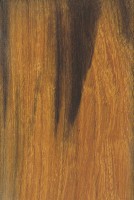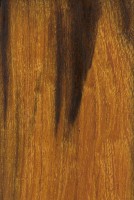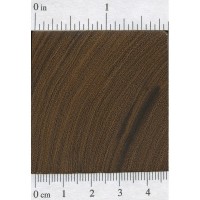 |
Common Name(s): Desert Ironwood Scientific Name: Olneya tesota Distribution: Southwestern United States and Northwestern Mexico Tree Size: 20-30 ft (6-10 m) tall, 1-2 ft (.3-.6 m) trunk diameter Average Dried Weight: About 75 lbs/ft3 (1,210 kg/m3) Specific Gravity (Basic, 12% MC): ~.97, ~1.21 Janka Hardness: 3,260 lbf (14,500 N) Modulus of Rupture: 10,880 lbf/in2 (75.0 MPa) Elastic Modulus: No data available Crushing Strength: No data available Shrinkage: No data available; reported to be very stable in service |
Color/Appearance: Heartwood color ranges from an orangish yellow to a darker red or brown, with darker violet to black streaks. Some pieces may be almost entirely black. Narrow yellow sapwood is clearly demarcated from heartwood.
Grain/Texture: Due to the small size of the tree, grain can be wild or gnarled. Fine even texture and excellent natural luster.
Endgrain: Diffuse-porous or semi-ring porous; large pores commonly in clusters and radial multiples of 2-5, few; tyloses and other heartwood deposits abundant; parenchyma banded, vasicentric, and confluent; medium rays, spacing normal.
Rot Resistance: No data available.
Workability: Very difficult to work on account of its density. High cutting resistance. Desert Ironwood is usually restricted to very small projects, though it takes a good natural polish and is very stable in service. Turns, polishes, and finishes well.
Odor: Desert Ironwood has a distinct, somewhat unpleasant smell when being worked.
Allergies/Toxicity: While there are no official studies available for Desert Ironwood, anecdotal reports suggest that the sawdust can be irritating to the skin and respiratory system. See the articles Wood Allergies and Toxicity and Wood Dust Safety for more information.
Pricing/Availability: The small size of the tree—in combination with its restricted distribution and relative rarity—means that Desert Ironwood is in scarce supply. Expect prices to be extremely high for a domestic hardwood, or par with many high-end exotic imported hardwoods. Usually seen as turning or knife blanks, also sold as whole logs.
Sustainability: This wood species is not listed in the CITES Appendices or on the IUCN Red List of Threatened Species. However, Desert Ironwood (known as palo fierro in Spanish) is considered a protected species in Mexico due to overexploitation and diminishing natural habitat.
Common Uses: Knife handles, carvings, and turned objects.
Comments: Desert Ironwood is perhaps one of the most highly-regarding of all woods in knife-making, with its density, stability, and grain patterns and colors creating a unique combination of characteristics that’s ideal for decorative handles. It’s also favored for carving by the indigenous Seri people now living in the state of Sonora in Mexico. (And because of it’s high thermal value, the wood is also cut and used as charcoal.)
None available.








I’ve seen hundreds of these trees up close and worked with the wood a ton. I can tell you, the heartwood is extremely rot resistant and full of oils that make it so that gum your tools up. The sapwood and bark rot away centuries before the heartwood even thinks about rot.
Is there a way to leech the natural oils out of woods like these, and stabilize them with resin to make them even more hardcore? Would stabilizing (in this case oil removal) help prevent allergies frequent with these kinds of wood? Is stabilization of super hard wood even doable?
Whats the difference between desert ironwood and Ipe?
Ipe is Brazilian Walnut. Completely different species and appearance.
Desert ironwood and ipe are in two different genera, (Olneya and Handroanthus) so they are obviously different trees. Desert ironwood trees are relatively small and slow-growing, while ipe is a much larger tree. Desert ironwood grows in the Sonoran Desert and the arid regions around it, while Ipe’s natural range is in the tropical regions of South America. The wood of desert ironwood is very heavy and hard, and it also is very stable in service. According to this website, Ipe wood is a little harder and lighter. While both woods are or have been overexploited to a degree, Ipe… Read more »
Bought vintage custom belt buckle & wrote artist-maker for info. David Yellowhorse wrote back & relayed wood used on buckle was this wood, which I’d never even considered. I’d assumed the buckle wood was walnut, or something similar. Finding out this information just increases my appreciation for this artists work.
It is a wonderful and unusual wood. It is absolutely necessary to use a full face mask, Olneya tesota wood contains toxic substances (they make the wood almost non-biodegradable!). It is worth noting that the Janka hardness scale is very unreliable – here’s an example: for many years in the same room I have been storing Desert Ironwood, Verawood, Mopane, African blackwood, genuine Lignum vitae…Desert Ironwood is definitely harder than Mopane and Verawood! This can be easily checked by making a mark with your fingernail on the polished surface. You can make a mark on Verawood, barely on Mopane, but… Read more »
I have a few pen blanks of Desert Ironwood – it turns pretty well and finishes beautifully!
I love this wood ! The only thing is it will take years off of your life. Use a respirator I bought a gas mask with a p100 filters. I cut the wood with a band saw to get the basic shape, then I use a rasp to get the finished shape. Then I start sanding by hand I start with 600 grit and work my way to 15,000 grit. I found if I go back to 6,000 grit and go through hand standing up to 15,000 grit . Itt blows my mind how beautiful the wood looks in the… Read more »
Just beautiful!
How is this compared to ironwood from Surinam or is it basically the same thing? And if it’s different what is the species name for ironwood from Surinam?
Suriname ironwood is a totally different species. Both are very heavy and hard. Species name is Bocoa prouacensis, it was formerly placed in the Katalox genus and is a very strong and tough wood.
Thanks Eric. I can’t find a ton of info on Suriname ironwood other than it’s hard and dense. How is it with finishes and how does it glue up. Is there anything to consider when glueing, routing, finishing etc. like I said info is pretty hard to find unless I’m looking in the wrong places.
I’d use the page on Katalox or Wamara as a good starting point. https://www.wood-database.com/katalox/
I bought some a few month’s ago to be knife scales.And I don’t know if there is a difference in the steele or the wood. In how hard it is I tried a small palm planer. It put a notch in the blade. I have been using this wood for a short time and my hands and arm’s hurt so bad l am like this for 3or 4 day’s. It does not matter if I carve it with a knife or just sand and polish it with a belt sander and polishing wheels. I use my n95 respirator. I was… Read more »
Hi Gordon. I have a 100 year old stash of turner harvested Arizona desert ironwood. I have many times had bad rashes on my hands and arms and a reaction rash if I touched my face or anywhere my skin was not calloused. No question, the dust from Desert Ironwood is Bad Medicine! Use respiratory and skin protection when working this wood.
Thank I now use a gas mask when I am sanding any wood. I don’t use my belt Sanders any more I found that using a rasp and hand standing cuts down the saw dust. Try using 600 grit then work your way up to 15,000 grit. By hand. Then go back to 6,000 grit and work your way up to 15,000 grit. It is amazing how it looks in the sun. Try it and let me know how it turns out.
Is this the same as Arizona desert ironwood?
yes
Ironwood does not really grow long straight limbs. While it is possible that something as you describe is out there; it is equally likely that there is a chicken with teeth
They need to update the toxicity on this page. Desert Ironwood can give you silicosis, as well as a lethal fungal infection of the lungs. Which is why natives used to die from carving it.
This is a gnarly wood.
Incredibly beautiful wood. I found I am allergic to it. I wear a respirator, long sleeves and gloves when I sand it. First time I worked with it I almost ended up in the hospital. I was on a steroid treatment for a couple of weeks.
Beautiful work.
I think I have some of this ironwood. A friend gave me some pieces left over from a deck. When I sans and plan it it has a yellow powder. Is this normal? Will the yellow come
Out over time when I oil it?
Maybe your friend had a deck or Ipe or Cumaru or some other hardwood. Desert ironwood doesn’t get big enough to be used for decking.
I cut hundreds of feet of it every day. I work for a dock builder. The longest boards we get in are 22′.
I strongly suspect we are talking about two different woods here. I would be very surprised to see a 22 foot long board of desert ironwood, that is to say, Olneya tesota. There are a lot of other woods that go by the common name “ironwood” — but only one Olneya tesota. I think you’d be hard pressed to find pieces of Olneya tesota that are 22 inches long, much less feet.
I agree, Eric, very well put.
You’re probably working with IPE Palupa. Not sure if I spelled it correctly.
My friend did a deck and it was Brazilian Ironwood. Totally different.
Thanks for all the advice re. working with this wood. Im new to the wood working world and got some chunks of this stuff to make a pistol grip shifter for my Mopar. Def going to use a respirator/eyeware!
Did you finish this project ? I’d love to see some pictures !
Bought a beautiful carved bear with a “salmon” in it’s mouth (removable) on the beach in Mazatlán. I decided to put it in my carry on bag vs my checked suitcase to protect it. I got to the TSA checkin and my carry on was pulled after the x-ray check. The bear was pulled out and I was told it was NOT ALLOWED AS A CARRY ON as it could be used as a weapon! I did not have time to go back to the airline to have it put in my checked suitcase! Fortunately my sister’s flight was another… Read more »
TSA comes in two varieties: perpetually stoned and messing with people for giggles, and straight-laced high-tension as can be and sufferring from paranoia-induced institutional daftness
Anything can be used as a weapon by a trained assailant….folded newspapers and credit cards can be outright deadly. Carvdd wooden bears though??? Lol
Just received a fine ironwood fingerboards from a pal in AZ. It’s *incredibly* dense and absolutely gorgeous – that said, he told me that it requires very sharp tools to work without issues.
I have a carved ironwood eagle that, unfortunately, sat in a sunny window for years and is now very bleached. Is there any way to restore its color?
To answer my own question, applying an oil finish restored the color. I used salad bowl finish.
I use brown Kiwi shoe polish. Try some on a small piece and let it dry. Then give it a good buffing. Hope that works.
People who say that desert ironwood is “brittle” should be aware that billies and clubs are made from this wood, as well as animal sculptures made by natives who don’t have complicated machines to carve them : the type of desert ironwood used then is not burl but straight grained wood (or slightly wavy grain). Burls tend to explode, crack, warp and twist when cut and ironwood being probably harder than maple,the problems encountered with usual burl materials will reach a new levevl of annoyance with hard exotic wood burls. I’m extremely curious to learn the fracture toughness, elasticity modulus,… Read more »
Yes, Desert Ironwood can be found in the south western part of Arizona. I am from Yuma Arizona and this stuff is everywhere around here. It is however protected. only pieces of wood that have fallen off of the remaining tree can be picked up and taken and you may not drag large pieces of wood through the desert or uproot a tree. Desert Iron wood is super hard, a lot harder than hard Maple or most other wood. it is composed of tiny wood fibers that when become airborne irritate the respitory system and eyes similar to pollen allergies.… Read more »
Is it just me, or does this species smell like bad morning breathe when sanding?
Wait until you get around either the tree “strychnos nux-vomica” : hell on earth. The latin name hints in the right direction, just guess.
On the other hand, desert ironwood is a “robiniae” which is closely related to the black locust(robinia pseudoacacia), but being also a faboidae like laburnum, they all reek -when freshly cut- of unripe crushed beans, well that’s the impression I had.
the scent almost disappears when well dried.
OMG, I would have to agree with that comparison. I’m glad he started reading this I’m going to go buy me a respirator today.
Get a p100 gas mask.
As far as work ability goes just a few notes. When its cured, it is very hard and very brittle. With my nice table saw and a brand new blade, a chunk broke of and gave me a bloody nose. Use sharp blades, bits, chisels, and tools, and sharpen often. Carbide bits and blades are recommended. That being said i love this wood. I me some pistol grips for my 1911, and just got more and more excited with each grit progression. I took it to 1000 then used superglue as the finish. Sanded that up to 2000 then polished… Read more »
In addition to allergic reactions, Desert Ironwood also contains a lot of silica which causes permanent damage to lungs.
It will fluoresce in direct sunlight or LED lights.
currently carving a knife handle of it, so far this is the most toxic wood I’ve worked with. I’ve experienced sneezing, coughing and nasal mucus flow (dribbling). antihistamines relieved the respiratory symptoms. I don’t normally react to wood dust. I tried working it under water, the wet sawdust left a dark purple stain on my hands that has taken three days to mostly ware off. I’ve been leaching the wood in soapy water with little to no effect other than temporarily darkening the wood. I recommend a respirator type mask and working it outside and rubber gloves if working it… Read more »
Just got done turning a razor stand and seem to be having a respiratory issue. Have become very stuffy and sneezing some,have turned once before and had a very mild reaction. I thought it was a cold coming on and didn’t really think about it till today. Had my dc running but didn’t have a mask on, will remember it next time. It doesn’t seem too serious, just an observation and something I will learn from as it’s the first ever reaction to wood dust I’ve had.
my one and only wood dust reaction occurred with this wood too. you definitely want to wear clothes and gear to keep this stuff off of your skin and out of your lungs. made me quite sick for about a day, and luckily no adverse reactions down the road. i had that reaction 25 years ago. i got halfway through the black side of a turned chess set, and my buddy used the remaining chunk i had for firewood. UGHHH!!!